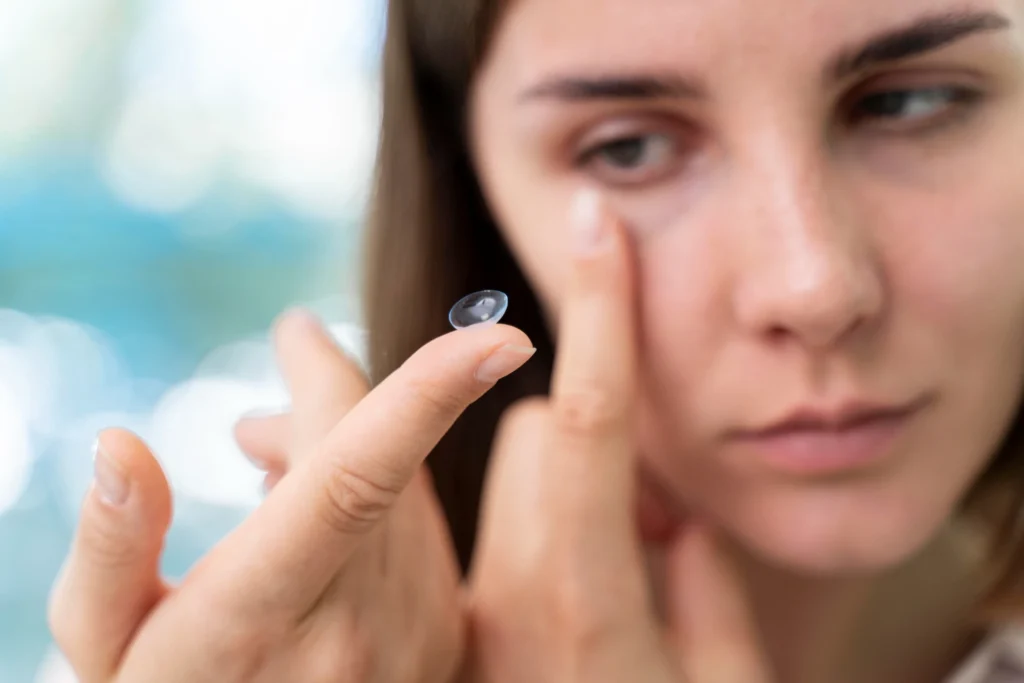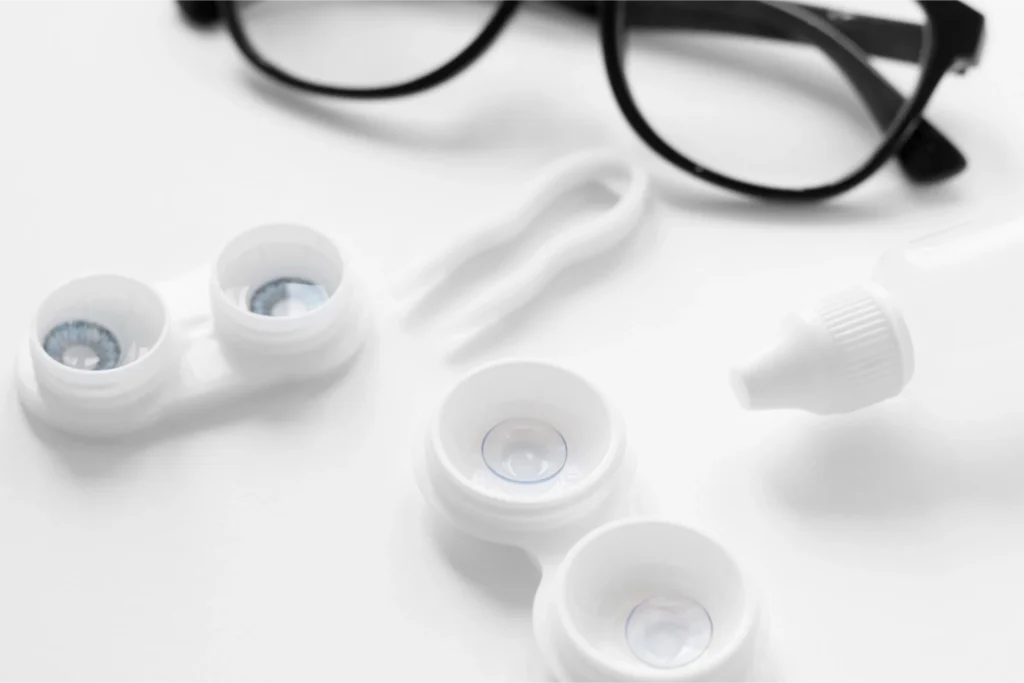Pink Eye vs Allergies
When your eyes are red, itchy, or watery, it can be hard to tell whether you’re dealing with pink eye or allergies. Both can cause irritation, puffiness, and discomfort but the causes, contagiousness, and treatments differ significantly. Understanding the difference between pink eye vs allergies helps you find the right relief and avoid unnecessary spreading of infection.
In this guide, we’ll explore how to tell allergic conjunctivitis vs pink eye apart, what symptoms to watch for, and when to see an eye specialist. Whether you’re searching for early signs of pink eye symptoms in adults or ways to soothe swollen eyes from allergies, this article has you covered and if your symptoms don’t improve, you may need professional eye allergy treatment to get lasting relief and protect your vision.
What Is Pink Eye?
Pink eye, also called conjunctivitis, is an inflammation of the thin membrane (conjunctiva) that covers the white part of your eye and the inside of your eyelids. It’s a common condition caused by infection, irritation, or allergens. The eye becomes red and uncomfortable, often with discharge or crusting that makes it difficult to open your eyes in the morning.
Common types include:
- Viral conjunctivitis: often caused by adenovirus and spreads easily.
- Bacterial conjunctivitis: caused by bacteria like staphylococcus or streptococcus.
- Irritant conjunctivitis: triggered by smoke, chlorine, or harsh chemicals.
Pink eyes can affect people of all ages, even infants.
Causes of Pink Eye
Pink eye can be caused by several factors, depending on the type of infection or irritation. Understanding these causes helps identify whether your condition is contagious or triggered by environmental irritants. Below are the most frequent culprits behind pink eye in adults and children:
- Viral infections such as adenovirus are the most common.
- Bacterial infections including staphylococcus and streptococcus.
- Irritants like smoke, chlorine, or makeup residue.
- Allergies or contact lens overuse can also contribute.
Symptoms of Pink Eye
The symptoms of pink eye often appear quickly, starting in one eye before spreading to the other. While mild cases can clear up on their own, recognizing these early signs can help prevent infection from worsening or spreading to others.
- Red or bloodshot appearance
- Thick, yellow or green discharge
- Burning or gritty feeling
- Crusty eyelids, especially in the morning
- Light sensitivity or mild pain
Is Pink Eye Contagious?
Yes, viral and bacterial pink eyes are contagious and can easily spread through direct contact with infected eye discharge or contaminated objects like towels, pillowcases, or makeup. This is why pink eye often affects both eyes if proper hygiene isn’t maintained.
While irritant-related conjunctivitis caused by smoke or chemicals isn’t contagious, it’s still uncomfortable and requires care to prevent irritation from worsening. Taking preventive steps can help protect you and others from infection.
Prevent infection by:
- Washing hands frequently
- Avoiding eye rubbing
- Not sharing cosmetics or contact lenses
- Replacing pillowcases often
What Is Allergic Conjunctivitis?
Allergic conjunctivitis, often referred to as allergy pink eye, occurs when the body reacts to allergens like pollen, pet dander, or dust mites. This immune response causes inflammation, leading to red, watery, and itchy eyes. Unlike infections, this type of conjunctivitis is not contagious and often flares up during allergy seasons.
Causes of Allergic Conjunctivitis
Allergic conjunctivitis develops when your eyes come into contact with specific allergens that trigger the immune system. These allergens can be indoors or outdoors, and identifying them is key to prevention and eye allergy treatment.
- Outdoor allergens: pollen, grass, or mold
- Indoor allergens: pet dander, dust mites
- Environmental factors: air pollution, perfumes, or smoke
Symptoms of Allergic Conjunctivitis
Symptoms of allergic conjunctivitis can mimic those of pink eye but are typically more itchy and watery rather than sticky. These signs often occur in both eyes and may coincide with seasonal allergies or exposure to irritants.
- Intense itching and watery discharge
- Redness in both eyes
- Mild swelling or puffiness
- Burning or light sensitivity
- Accompanied by sneezing or nasal congestion
Is Allergic Conjunctivitis Contagious?
No, allergic conjunctivitis is not contagious. It’s triggered by allergens, not bacteria or viruses. Symptoms often appear seasonally or immediately after allergen exposure. While not harmful to others, untreated eye allergies can make daily life uncomfortable. Using antihistamine eye drops for allergic conjunctivitis or limiting exposure to triggers can bring quick relief.
Pink Eye vs Allergies: How to Tell the Difference
It’s easy to confuse pink eye vs allergies, but their underlying causes and sensations are quite different. Paying attention to the type of discharge, itching level, and timing of symptoms can help you pinpoint the source of your discomfort.
Comparing Symptoms Side by Side
| Feature | Pink Eye | Allergic Conjunctivitis |
| Discharge | Thick, yellow/green | Watery, clear |
| Contagious? | Yes (viral/bacterial) | No |
| Onset | Sudden, one eye | Seasonal or both eyes |
| Main Sensation | Gritty, burning | Itchy, watery |
| Additional Signs | Crusty lashes, morning stickiness | Sneezing, runny nose |
Treatment Options and Relief
Finding the right treatment for pink eye or allergies depends on the cause. While bacterial infections may need medical drops, allergy eye treatment focuses on soothing inflammation and minimizing exposure. Always consult an eye care professional before starting new medications.
For Pink Eye
When treating bacterial vs viral pink eye, professional diagnosis is crucial. Both types can be managed with proper hygiene and medication, but bacterial forms often need antibiotics.
- Use antibiotic or antiviral eye drops if prescribed
- Apply warm compresses for comfort
- Avoid contact lenses and eye makeup
- Clean crusty eyes gently with a damp cloth
Practice good hygiene to prevent spreading
For Allergic Conjunctivitis
Managing allergic conjunctivitis vs pink eye requires a focus on allergen control and symptom relief. Eye drops and lifestyle changes can quickly reduce irritation and puffiness.
- Use antihistamine or lubricating eye drops
- Limit exposure to allergens (keep windows closed during pollen season)
- Apply cold compresses to reduce swelling and itchiness
- Try over-the-counter allergic conjunctivitis eye drops for quick relief
- Ask your doctor about allergic conjunctivitis medication if symptoms persist
When to See an Eye Specialist
Sometimes, red or irritated eyes signal more than allergies or mild infection. Persistent symptoms, pain, or vision changes should be evaluated by a professional to prevent complications or misdiagnosis.
Seek medical help if you notice:
- Severe eye pain or blurred vision
- Persistent redness or discharge
- Swelling that doesn’t go away
- Symptoms spreading despite home treatment
If you’re unsure whether it’s pink eye or allergies, book an appointment for a clear diagnosis and eye allergy treatment plan. Early care ensures fast relief and long-term eye health.
Protect Your Vision with the Right Eye Care
Knowing the difference between pink eye vs allergies can save you discomfort, prevent spreading infection, and ensure proper treatment. While pink eye often needs medical attention, allergy pink eye usually improves with avoidance and soothing drops.If you’re struggling with red, itchy, or irritated eyes, visit Vision Gallery for expert care. Our specialists provide effective pink eye and eye allergy treatments, helping you see and feel your best. Book your appointment today or call 281-398-4000 to experience the clear, healthy vision you deserve.






